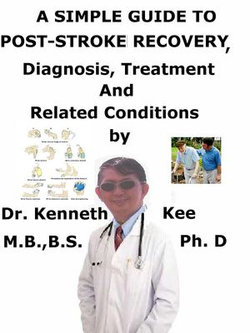This book describes Post-stroke Recovery, Diagnosis and Treatment and Related Diseases
When a stroke happens, areas of the brain become injured and many of these brain cell connections are demolished.
That is the reason why many patients have problems with movements after a stroke because the neural connections that manage movement have been affected.
Neuroplasticity is the ability of the nervous system to alter its activity in reaction to intrinsic or extrinsic stimuli by reorganizing its neural structure, functions, or connections after injuries, such as a stroke or traumatic brain injury (TBI).
A stroke happens when blood supply to the brain is interrupted by either a blocked artery (ischemic stroke) or a ruptured artery (hemorrhagic stroke).
When blood supply is affected, it decreases the brain cells of oxygen, causing severe brain harm.
The treatment for stroke requires clot-busting medicines and occasionally surgery, depending on the type and site of the stroke.
Even if treatment is given quickly, the brain damage from a stroke can still produce secondary stroke effects, such as:
Muscle weakness or paralysis on one side
Numbness or tingling of one side
Speech and language difficulties
Difficulty in swallowing (dysphagia)
Cognitive disorders
1.Flaccidity
The 1st stage is flaccidity of the muscles that happens immediately post-stroke.
Some interventions may be:
Range of motion exercises
Positioning (can help prevent sores, joint restrictions, swelling, and dislocation)
Sensory re-education
Hand-over-hand assistance during activities of daily living
2.Spasticity
The 2nd stage is the appearance of spasticity.
Spasticity is the presence of muscle stiffness and rigidity.
The patient will persist with passive range of motion exercises and put in in active-assisted range of motion exercises
Spasticity exercises may also be:
Sensory re-education
Hand-over-hand assistance with functional activities
Mirror therapy
3.Increased Spasticity
In the 3rd stage, spasticity becomes even worse.
The patient may feel frustrated that the spasticity of muscles is becoming worse and not moving forward in the stroke recovery.
Again, this rise in spasticity is actually a good sign since it indicates that the brain is rebuilding connections with the muscles.
Some helpful exercises are:
Mirror therapy has been proven to help restore active movement to the affected side.
The patient may use splints or orthotics
4.Decreased Spasticity
In the 4th stage, spasticity starts to decrease.
When spasticity diminishes, the patient will observe improved voluntary movement actions
Interventions in this 4th stage will capitalize on the restored voluntary movement
Constraint-induced movement therapy may be initiated
5.Complex Movement Combinations
In the 5th stage, a person can start to coordinate complex movement combinations.
This might involve grasping a spoon, filling it with food, getting it to the mouth, bringing the spoon back to the table, and releasing it.
The patient will continue with the exercises at this point, increasing repetitions and resistance
6 Spasticity Disappears with Coordination Reappearing
In the 6th stage, spasticity has completely gone.
The patient may act on retraining more complex and demanding functional activities
7.Normal Function Returns
In the 7th and final stage, normal function can be restored.
In some people, there is a complete recovery
TABLE OF CONTENT
Introduction
Chapter 1 Post-stroke Recovery
Chapter 2 Treatment Methods
Chapter 3 Upper Limb Rehabilitation
Chapter 4 Lower Limb Rehabilitation
Chapter 5 General Rehabilitation
Chapter 6 Optimizing Rehabilitation
Chapter 7 Stroke
Chapter 8 Post Stroke Tremors
Epilogue



Share This eBook: